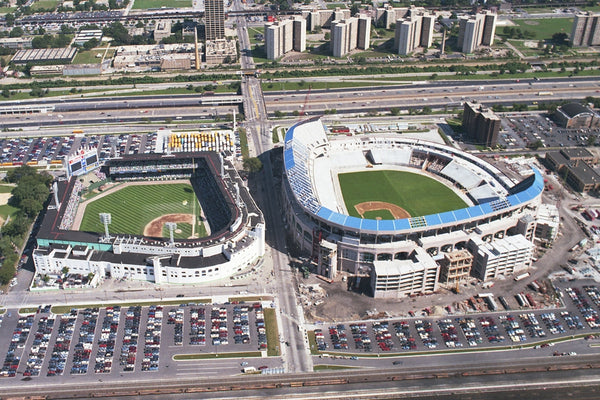Ballpark Profile: Guaranteed Rate Field
Name: Guaranteed Rate Field
Location: Chicago (South Side), Illinois
Opened: 18 April 1991
Architect: HOK Sport
Cost: $137 Million
Capacity: 44,321 (original)
40,615 (current)
Surface: Kentucky Bluegrass
Guaranteed Rate Field, AKA US Cellular Field, AKA New Comiskey Park, is . . . a pretty nice place to see a baseball game. It had an opportunity to be really special, but it also had a period of being really not very nice, so the fact that it is a pretty nice place to see a game today is a good thing.
New Comiskey Park (as it was originally called) replaced the classic but aging Comiskey Park, where the White Sox had played for the preceding 81 years. How much thought was given to refurbishing/renovating/updating Old Comiskey is not known, but presumably not much. This was the beginning of the building boom for new ballparks in baseball, and, as we've profiled before, the objective was to maximize corporate and luxury box space and revenue.
Thus, the jewelbox Old Comiskey was scheduled for a tear-down and a new, state-of-the-art stadium earmarked for its place.

I mentioned the opportunity that New Comiskey had; the last two MLB parks built before it were the SkyDome in Toronto and Tropicana Field in Tampa, both muti-use domes, and not ballparks at all. The last real ballpark built before New Comiskey was Kauffman Stadium in Kansas City, almost 20 years prior.
And the next one to be opened after New Comiskey? The landmark, groundbreaking, iconic, magical Oriole Park at Camden Yards. New Comiskey, built at about the same time and designed by the same architects, could have been the prototype for the new era of retro ballparks, but unfortunately, they had different priorities.
As mentioned here, HOK Sports's plans for the new ballparks in Chicago and Baltimore were quite similar, but the Orioles brought in an architectural consultant to serve as VP of Planning and Development who steered the architectural tean down the retro path that ultimately developed Camden Yards. The White Sox, on the other hand, made plans for a symmetrical, almost cookie-cutter-style stadium that was intended to be built in suburban Chicago. When circumstances changed and they ultimately decided to build in the parking lot of Old Comiskey, any thoughts of asymmetry or building-to-site were ignored, and the symmetrical, suburban-styled park was plopped down next to the old place.
And, as mentioned above, the priority was for luxury boxes and corporate spaces, so two (and in some places three) levels of luxury boxes were added, leading to the cocktail-party trivia that most Chicago sports fans have heard: the front row of the upper deck at New Comiskey was as far from the field as the LAST row at Old Comiskey.

And the last row at New Comiskey . . . nobody likes talking about that. The upper deck was steep, closed, and, by all accounts, a very unpleasant place to sit. The entire seating bowl was comprised of cheap-feeling blue plastic seats, and the structure and concourses were -- in many places -- unadorned poured concrete. Very utilitarian, but lacking in any element of ballpark charm.

The end result being . . . a pretty nice place to see a ballgame. It does not have some of the great elements of more recent parks, but we do have to remember that New Comiskey was built before ANY of the parks that have those elements; it can be argued that every park has the potential of improving based on experiences of the parks opened before it. Guaranteed Rate had NO other new parks to reference.
While the sightlines and concessions and ancillary ballpark experiences are average-ish for a new park, Guaranteed Rate doesn't really have any kind of ballpark village feeling that it seems every new park is trying to achieve. In fact, when researching this profile, I was blown away to read that the White Sox had a provision in their lease that prohibited local businesses from operating in the area. The idea being, presumably, that fans would then be forced to spend all of their food/drink revenue inside the ballpark, increasing the White Sox's take.

The result got them exactly that: a lot of parking lots, a freeway, freight railroad lines, an elderly home, a rubber manufacturing plant . . . and zero neighborhood bars or restaurants you could walk to after the game. A real shame.
Bottom line? Guaranteed Rate is not the best ballpark in baseball. But it is way better than it was, and is absolutely worth going to catch a game. It would be worth it on its own account, but there is the absolute joy of catching a Wrigley day game and a G-Rate night game, or catching games on back-to-back days on a weekend trip to Chicago that should -- must -- be on every baseball fan's bucket list.
And -- unlike so many of the "better" ballparks that have absolutely nothing to show on the field -- the White Sox are a must-watch team now, and for the next several years. In my heart I'm more of a Cubs fan, but it is hard to argue that there is a team with a brighter future than the White Sox. And we wish them, and their fans, nothing but success.
Have your own thoughts on New Comiskey/US Cellular/Guaranteed Rate? Post a comment below for a chance to win a FREE PRINT from Ballpark Blueprints!
